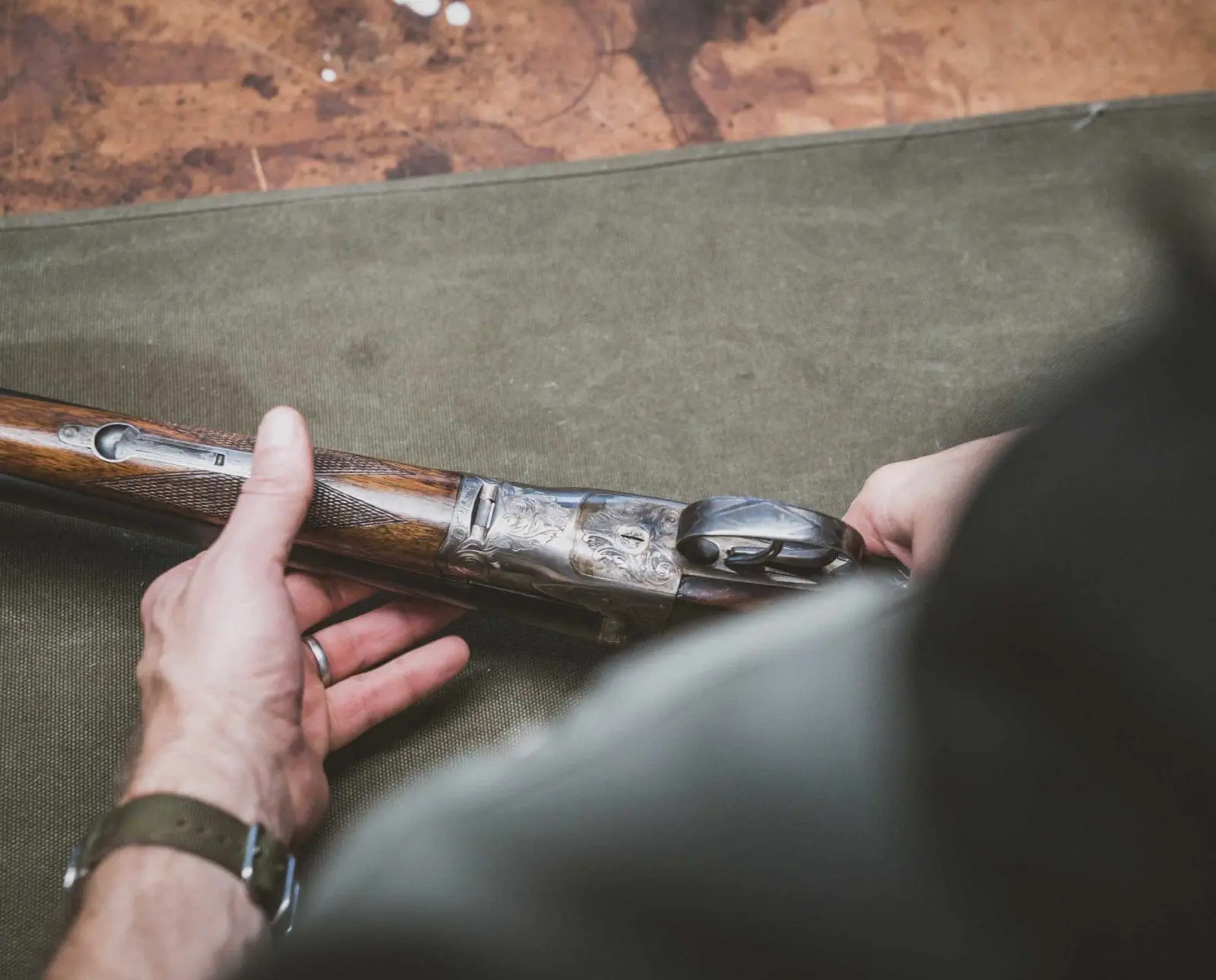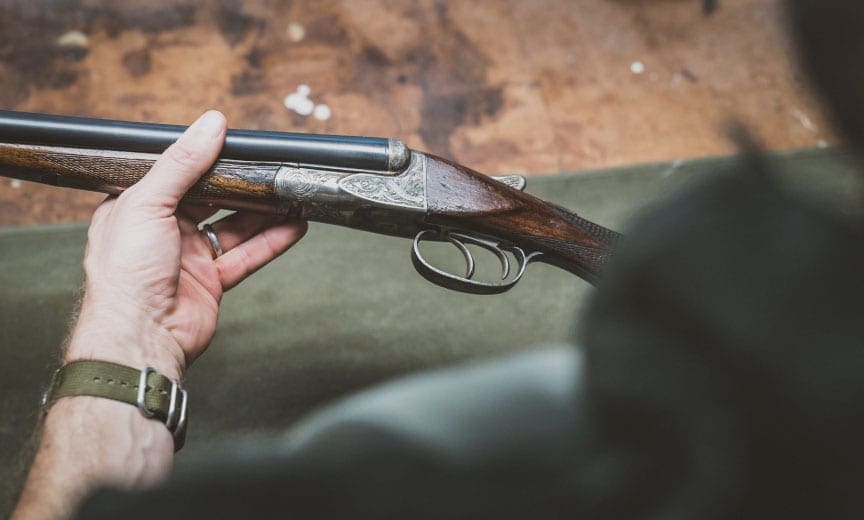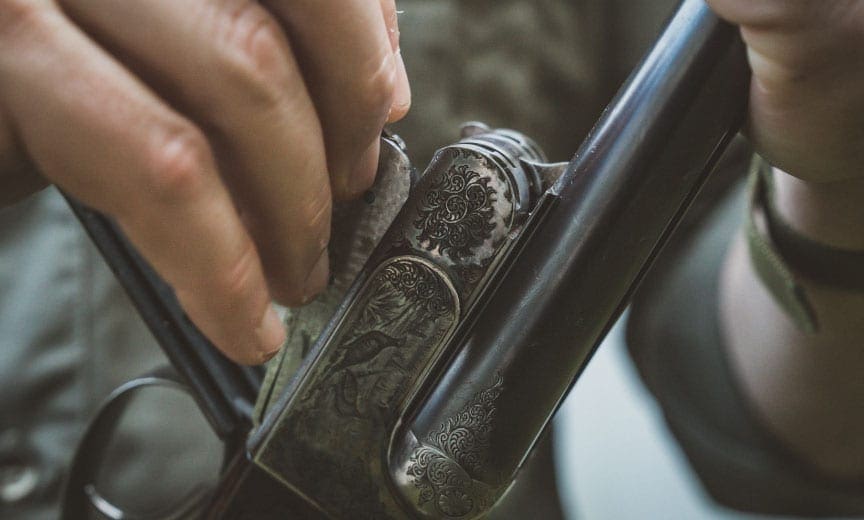Home » Firearms and Shooting » Shotguns » A Beginner’s Guide to Collecting Vintage Side-by-Side Shotguns
A Beginner’s Guide to Collecting Vintage Side-by-Side Shotguns

Gregg Elliott is the Shotgun Editor for Project Upland. He's…
Your introduction to vintage side-by-side shotguns
This article originally appeared as “Avoiding Double Trouble” in Issue Zero of Project Upland Magazine.
What do you love about bird hunting? For me, it’s everything from the clanging of dog bells and the smell of woodsmoke outside my cabin at night to the bittersweet emotions I feel when I kill a bird as beautiful as a American woodcock.
Of course, I also love the guns, especially vintage side by-sides.
I’ve been obsessed with old side-by-sides for decades now. I’ve owned ones by all the major American makers, and I’ve owned others from the United Kingdom and other European makers. I actually haven’t owned a gun—like a Holland & Holland Royal or a Dickson Round Action, but I’ve held many examples in my hands. Even with all this experience, I learn new things about old shotguns all the time.
So if you’re looking to buy a vintage shotgun, trust me when I say there’s a lot you need to know before you buy one. Here’s a crash course to get you going. Before we begin, I’ll also give you a warning: Old doubles are addictive. Don’t be surprised (or sorry) if you find yourself spending hours learning about them and looking for the perfect one. It will be time well spent
What makes them the same
Gunpowder was invented about 1,000 years ago, and firearms have been around since the 14th Century. The side-by-sides we use today came about in the mid-1800s. Starting around 1860, gunmakers in the United Kingdom, United States, and continental Europe developed hundreds of ideas for shotguns loaded from the breech instead of from the muzzle. By the time World War I began, most major makers had perfected their own versions of these ideas.
While these shotguns differed in some ways, they all had a handful of common features.
- Action: This is the metal section in the middle of a shotgun, and it’s where the barrels attach to the firearm. The action houses the gun’s locking and opening mechanism, and, depending on the design, the locks.
- Locks: These make a shotgun fire. In their most basic form, locks are just a hammer, a mainspring, and a sear. When you pull the trigger, the sear frees the hammer which is under pressure from the mainspring. The hammer snaps forward and sets off the shell. Bang!
- Barrels: Of course, every gun has at least one of these. Side-by-sides have two. Shells go in the back, and, when the gun is fired, a cloud of shot comes out the front. On side-by-sides, the barrels are—you guessed it—beside each other.
- Chamber: This is the back of the barrel where you insert the shells. The length of the chamber corresponds to the maximum length of the shotgun shells that fit in it. So a 2¾-inch chamber takes shells up to 2 ¾ inches long, a 3-inch chamber takes shells up to 3 inches long, and so on.
- Triggers: Side-by-sides have either two (double triggers) or one (a single trigger). With double triggers, each one fires a single barrel. Normally, the front trigger fires the right barrel first. With a single trigger, the trigger fires one barrel, then the other, each time it’s pulled.
- Stock and fore-end: The stock is the wood at the back of a shotgun. It’s what you press against your shoulder. The fore-end is the wood ahead of the action and beneath the barrels. It houses some components for the gun and helps to fasten the barrels to the action.
Stocks come in three basic styles: Straight grip, half-pistol grip, and full-pistol grip. The first is the slimmest, the last is the fattest and fullest. Fore-ends go from splinter to full beavertail, with similar slim-tofat proportions
What sets them apart
- Boxlock or sidelock: On some side-by-sides, the action is box-shaped and the locks are mounted inside this box. These are called boxlocks. On other side-by-sides, the locks are mounted on plates that are fitted onto either side of the action. These are called sidelocks.
- Locking and cocking mechanisms: While a Parker looks like a Fox, and a Purdey looks like a Holland, each of these shotguns uses a unique mechanism to cock its locks and secure its barrels to the action. Some of these mechanisms, like the ones on the Fox, are simple. Others, like what you find on a Purdey, are complex.
- Ejectors or extractors: These come into play after you fire a double-barreled shotgun and open it to reload. If a shotgun has ejectors, they kick the fired shells out of the chambers and away from the gun. Guns without ejectors have just extractors. Extractors lift the shells from the chambers but do not kick the shells free after they’ve been fired. Instead, you have to remove these shells by hand whether they’ve been fired or not.
- Fit and finish: While it’s absolutely unwise to make any absolute statements about vintage shotguns, your average British and other European side-by-side tends to be of higher quality than your average American double.
What do I mean by quality? For starters, I’m talking about the way the toplever, action, and other metal parts are filed and shaped, the way the locks and trigger guard fit into the stock, the shaping and aesthetics of a gun, and how it feels in your hands.
Better-quality side-by-sides do a better job at all of these. The action and triggers look like someone spent more time creating them (because they did); Metal and wood don’t just meet, it looks as if they have grown together. And the gun feels dynamic and alive, whether you’re shooting it or just carrying it in the field.
Then there’s how everything goes together and works: On a top-quality gun, the for-end pops into place without you having to squeeze it home; the gun opens without any grinding or resistance; and when you work the safety and pull the triggers, they don’t creep and drag. Instead, they break like dry kindling.
The more guns you see, handle, and shoot, the more these differences will become apparent to you.

Buy smart: Three rules to start
You’ll never forget your first side-by-side shotgun. Mine was a 16-gauge Fox Model B, and if I was looking to buy one of those guns today, here are three rules I would follow.
- Rule #1: Look for original condition. This is where you want to focus most of your attention. The more original condition (original finish) a vintage double has, the less it has been used and abused. The more it will cost you, too—especially if it’s American made.
- Rule #2: Check the barrels first. If a shotgun has heavily pitted or damaged barrels, you should probably forget about it, regardless of how much original condition it has. Don’t forget to buy smart. Here are three rules: Look for original condition, check the barrels first, and fit is a huge factor for success. Why? Because bad barrels can be expensive to fix—if they can be fixed at all. They can be dangerous too.
- Rule #3: Fit is a huge factor. Shotguns are pointed, not aimed like rifles. For a shotgun to point where you want it to, it has to fit you. Unfortunately, a lot of old American side-by-sides don’t fit today’s shooters. So while you may fall in love with a pre-World War II, 16-gauge Parker with tons of original condition, if it doesn’t fit you and you can’t hit anything with it, you probably won’t like it
Major shotgun makers
Thousands of gunmakers have built side-by-side shotguns over the last century and a half. As you begin your search to buy one, here are a handful of those makers to research. Their guns have stood the test of time, and if you buy one in good, original condition, it should serve you well for decades to come.
The Americans
- A.H. Fox Gun Company: Founded by Ansley Herman Fox in 1906, this company built doubles until it was bought by Savage Arms in 1929. Savage continued to build guns under the A.H. Fox name into the 1940s. A.H. Fox guns came in 12-gauge, 16-gauge, and 20-gauge. Their total production was around 180,000 guns.
- Ithaca Gun Company: One of America’s most successful gun makers. Ithaca opened in 1883 and built a number of different boxlock-style side-by-sides, including the Crass, Lewis, Flues, and NID. The company stopped making side-by-sides in 1948. They built over 300,000 of them in all—more than any other US maker.
- L.C. Smith: This is the maker of America’s only mass-produced sidelock shotgun. L.C. Smith started in 1881. Side-by-side shotguns were built under the L.C. Smith name until 1950. There were probably over 150,000 L.C. Smiths made.
- Lefever Arms Co: Introduced in 1883, these side-by-sides are part boxlock, part sidelock, and the first commercially successful hammerless shotguns made in the United States. Shotguns bearing the Lefever Arms Co. name were made until 1919. In all, around 73,000 were built.
- Parker Brothers: Parker Brothers Shotguns is America’s most famous side-by-side maker. Founded in 1868 in Meriden, Connecticut, Parker Brothers was sold to Remington Arms in 1934. From 1868 to 1947, just over 242,000 Parker shotguns were made.
The British
- Westley Richards: Founded in 1812 and still in business today, Westley patented two of the most famous shotgun designs of all time: the Anson & Deeley boxlock shotgun and the “detachable lock” action. So far, they’ve made over 25,000 doubles.
- W.W. Greener: Famous for their side safeties and crossbolt action, Greener used to have one of the largest gunmaking factories in the United Kingdom. The company has been around since 1829. Today, they’re making some of the finest guns in the world. In total, Greener has built over 30,000 guns.
- Holland & Holland: Holland & Holland is the builder of the famous “Royal” shotgun, and one of the most famous gunmakers in the world. Holland & Holland has been selling guns since 1835, and they’ve made doubles for kings, heads of state, and wealthy people around the world. They’re still in business, and so far they’ve built over 45,000 shotguns and rifles.
Other European Makers
- Belgian: Defourny, Francotte, and Lebeau-Courally
- French: Guyot, Manufrance, and Verney-Carron
- German: Charles Daly, Heym, and Merkel
- Italian: Beretta, Franchi, and Piotti
- Spanish: AYA Shotguns, Arrieta, and Ugartechea

Gregg Elliott is the Shotgun Editor for Project Upland. He's been interested in shotguns and gundogs since he was a kid. Today, he blogs about both at www.DogsandDoubles.com and posts to Instagram @dogsanddoubles





Good article! And you’re right it’s addictive! I bought two 1920’s doubles, Ithaca NID 12 gauge and NR Davidson & sons 20 gauge! I have to say they both fit great but I think I like the 12 gauge better. I’ve been online for hours looking up these guns!!
Glad you liked it. Those NIDs are good guns. Good hunting!
One of the most interesting things not mentioned is the “guild gun”. Many of these guns exist with a “makers” name stamped on it but are the work of several (many?) specialist manufacturers like action maker, barrel makers, stockers, etc.. Some of these are quite good but are often difficult to identify as guild guns.
Agree on the guild guns. I have a St Etienne Helicobloc guild and only the barrel maker is identified.
Wondering if mine is a guild gun. 12ga, skeet/improved. Box lock. Serial number below 1,000. No brand markings but similar in style to a Greener. Japanese symbol (two letters?) etched under the flat plate of the barrels. “S” stamped under each barrel. Local gun enthusiast suggest barrels were made by Schilling Brothers in Germany. 25 inch “metric” length. Silver colored action/receiver with beautiful etching
Hard to tell without seeing pics. Send some to me and tell you all I can about the gun: gregg@dogsanddoubles.com
Gregg
You’re right. They can be nice guns and great deals. “Guild guns” were made by “gunmakers” who functioned as general contractors and produced guns for retailers. Some of these retailed called themselves “gunmakers”, but never built a gun. This was very common in the Belgium & France and Austria. The retailers would order guns from the general contractors. The GC would source the guns from various craftsmen.
Any thoughts on 12 gauge sauer and son shot gun?
Sauers can be great guns. They made all sorts of models & grades, though. Any more details?
Thanks for the comment.
Gregg
any recommendations on how to find some good side by side options? (besides gun broker, etc). Is there a quality vintage online broker? I’m looking for a side by side 16.
thanks!
The best place to look is Gunsinternational.com. Thanks for the comment.
Great read. What are your thoughts on the Stevens 311/5100 side by sides?
Hey, JP. Both are decent, but I prefer the 311. Little easier to maintain and keep up and running if anything goes wrong with it.
Wondering about an over/under made by C.W. Lindsay of Houston, Texas. Any info would be helpful.
I’m not sure. They’re pretty rare guns. It looks like this one was made in Germany according to Lindsay’s patent: https://www.rockislandauction.com/detail/63/618/attractive-cw-lindsay-engraved-over-and-under-box-lock-shotgun
found a double barrel with C.Parkner & Co Boston stamped on it and can’t find any information on it. Is this a Parker knock off?
Yeah – it’s probably a Belgian gun / Parker knock off. I’ve never heard of that “make” and I can find any info on them.
Quick question–I have a 1926 Ithaca 20 gauge NID–were all the NID’s made to shoot 23/4 shells or did some shoot only 21/2 shells–I have come across conflicting reports–because of that I only use 21/2 to be on the safe side–what is also unique is that this gun came with a beavertail fore grip–
That’s a good question. Check out this thread for more info:
http://www.doublegunshop.com/forums/ubbthreads.php?ubb=showflat&Number=203430&page=1
Great article but what about the avowed king, the Purdey?
Great guns…but THE king? I don’t know. It’s hard to beat a Boss from the ’30s, and Boss OUs are better than any of the Purdey OUs.
Gregg
I have an old Damascus dbl marked on the receiver – W H Sparhawk with ” Fine Damascus Barrels” in the rib..no other markings have been found..any help in id would be welcome..thank you
Huh. I’ve never heard of that maker, and a Google search doesn’t turn up anything. Strange.
Could you post some pics?
Gregg
Very well written article. Thanks.
What manufacturers would you recommend looking at for a 12 gauge with 2” barrels? 2 1/2”?
i wish I could afford this addiction, I have 3 s xs 12(AYA),20 and 28 both newer CZ love being able to change chokes.
I have two Lefever 16 gauge. An “A Grade” and a “Nitro Special”. Any idea on when the A Grade was made, and how many? I have never seen another.
Sorry, Bill. I just saw this. I think the A-grades were made in the ’30s. Not many were built, maybe 2000 or so. A 16g is a rare gun. They’re nice, too.
Although not break action shotguns but definitely side-by-sides are the French Darne and Charlin “sliding action” shotguns from Saint-Étienne. They are really beautiful shotguns. Although if side-by-sides are not for everyone this is especially true for these sliding action shotguns. Love them or hate them, but almost impossible to ignore them, I think.
I didn’t realize that side-by-sides have either double triggers or single triggers. My grandfather has always been interested in vintage firearms. I am trying to figure out what gift I should get him for his birthday, I wonder if something like this would be a good idea.
I nice SxS would be a great present. But a decent one won’t be cheap.
Gregg
Winchester model 21 gets no love?
Hello Gregg,
My father picked up a double barrel 16ga in Germany during combat WWII and I am having difficulty identifying it. If I sent you some pictures would you be able to point me in the right direction? I am not interested in selling it so much as just knowing its origin and maker. It has a second attachable side by side barrel with 16ga + 8.7mm rifle barrel (9.3x72R perhaps).
Thank you in advance,
Mike
Hey, Micheal.
Send pics of it to me at gregg@dogsanddoubles.com
I’ll take a look and let you know what I can.
Gregg